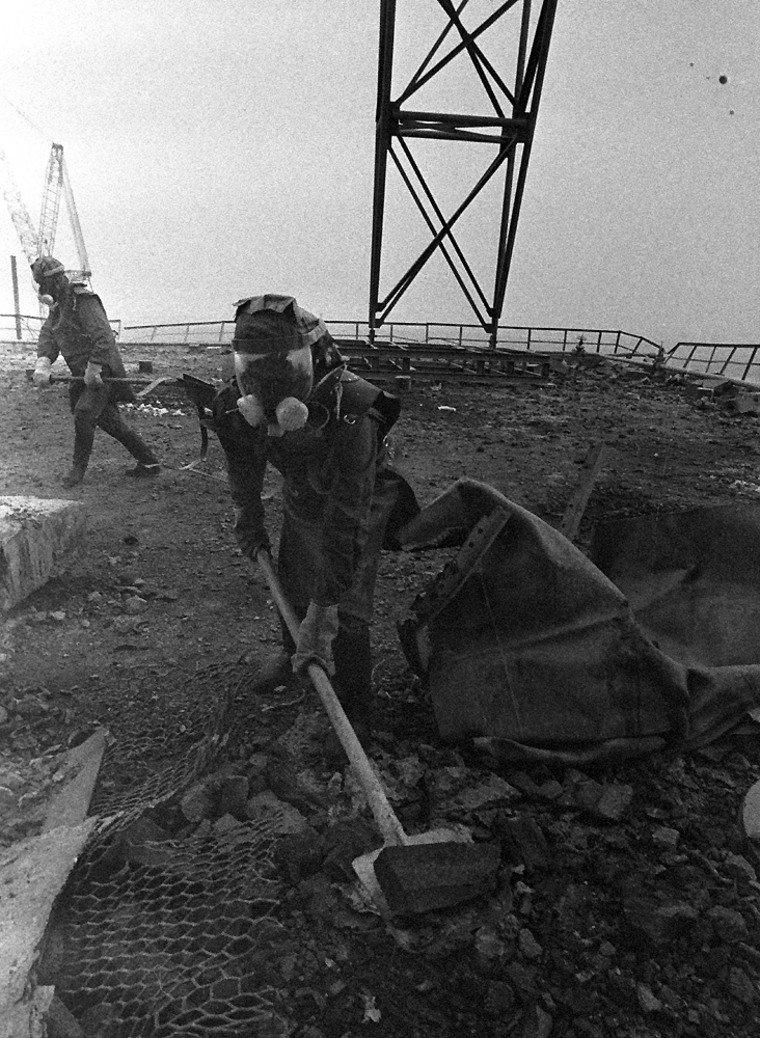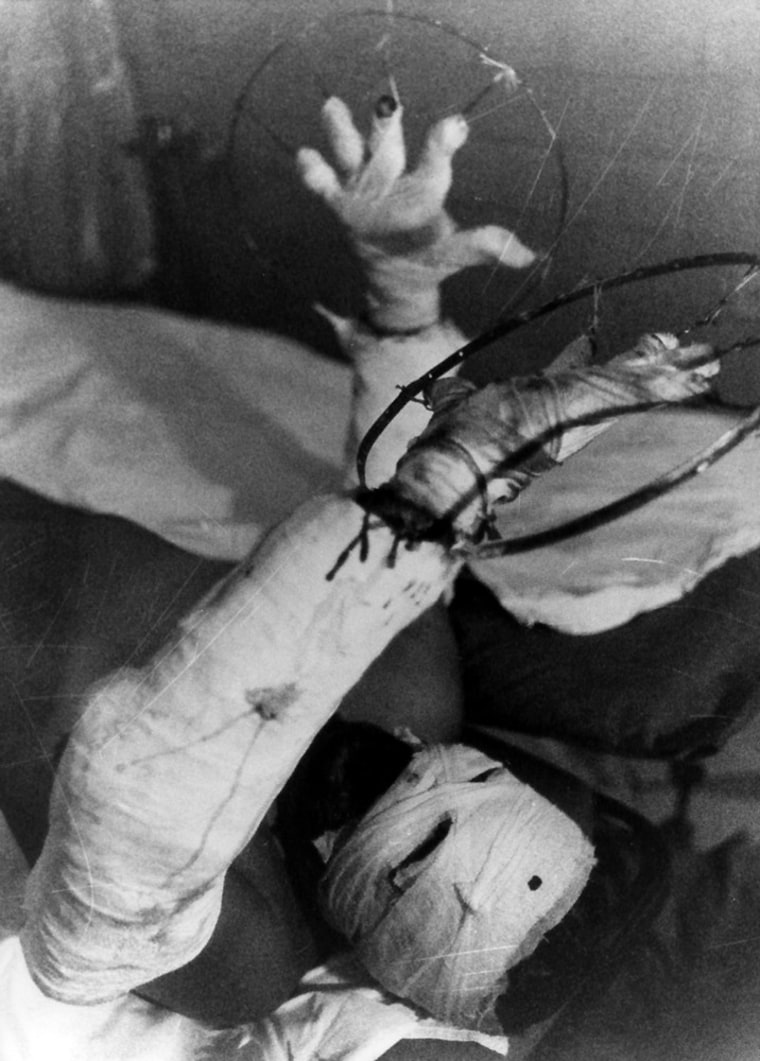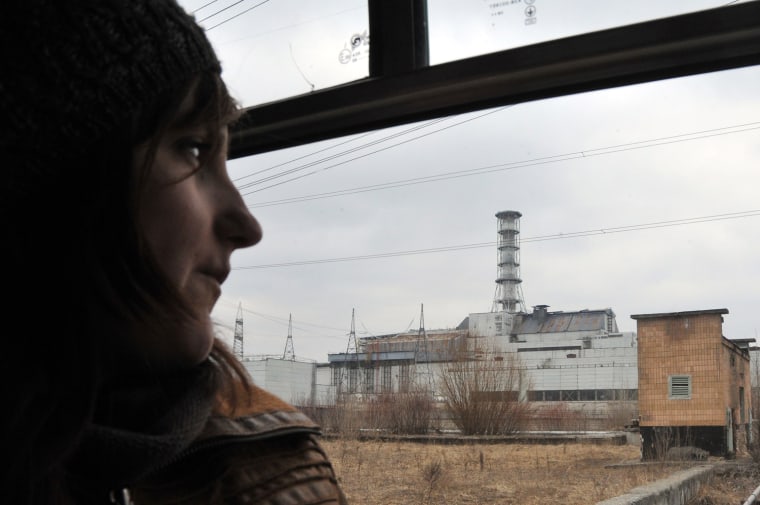IE 11 is not supported. For an optimal experience visit our site on another browser.
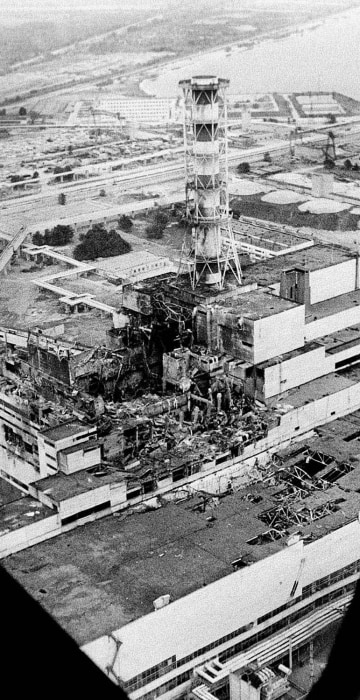
World
The fallout from Chernobyl
The world’s worst nuclear accident at Chernobyl took place 25 years ago when a blast at the power plant spewed a cloud of radioactive fallout over much of Europe and forced hundreds of thousands from their homes in Ukraine, Belarus and western Russia.
/ 29 PHOTOS

** FILE ** This aerial photo of the Chernobyl nuclear power plant taken two or three days after the April 1986 Chernobyl nuclear plant explosion and fire. Ukraine will mark the 21th anniversary of the Chernobyl's nuclear disaster on Monday, April 26, 2007. (AP Photo/Volodymir Repik)
— Volodymir Repik / AP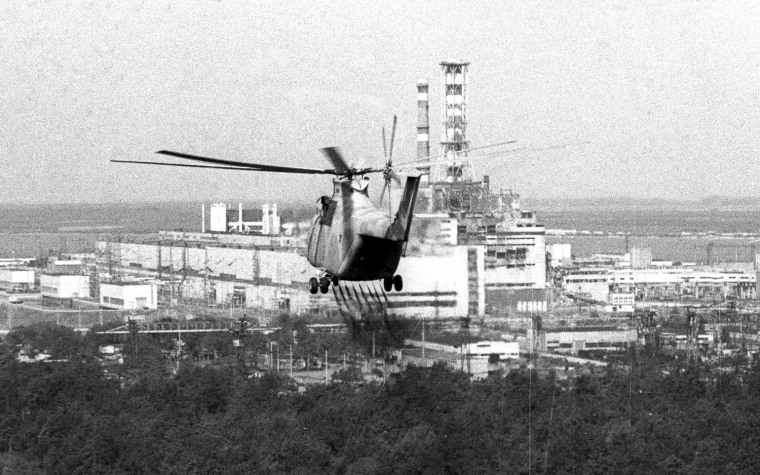
In this 1986 photo, a helicopter throwing chemicals to suppress radiation approaches the 4th destroyed reactor at the Chernobyl nuclear power plant in. On May 12, 1986, more than two weeks after the explosion, the leading Soviet daily newspaper Pravda published its first photograph from the site for the first time, shot three days earlier from a helicopter by Repik. \"If I had been ordered now to get aboard and go, I would not have gone _ you might have easily died there for nothing,\" said the 65-year-old Repik. (AP Photo/Volodymyr Repik)
— Volodymyr Repik / AP
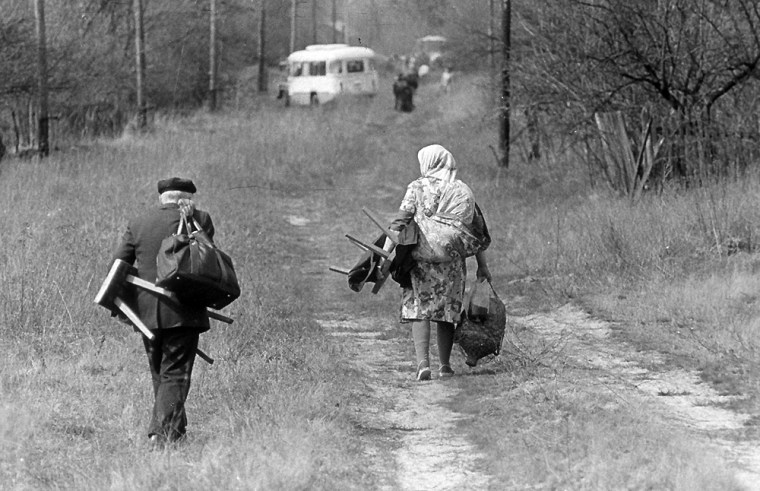
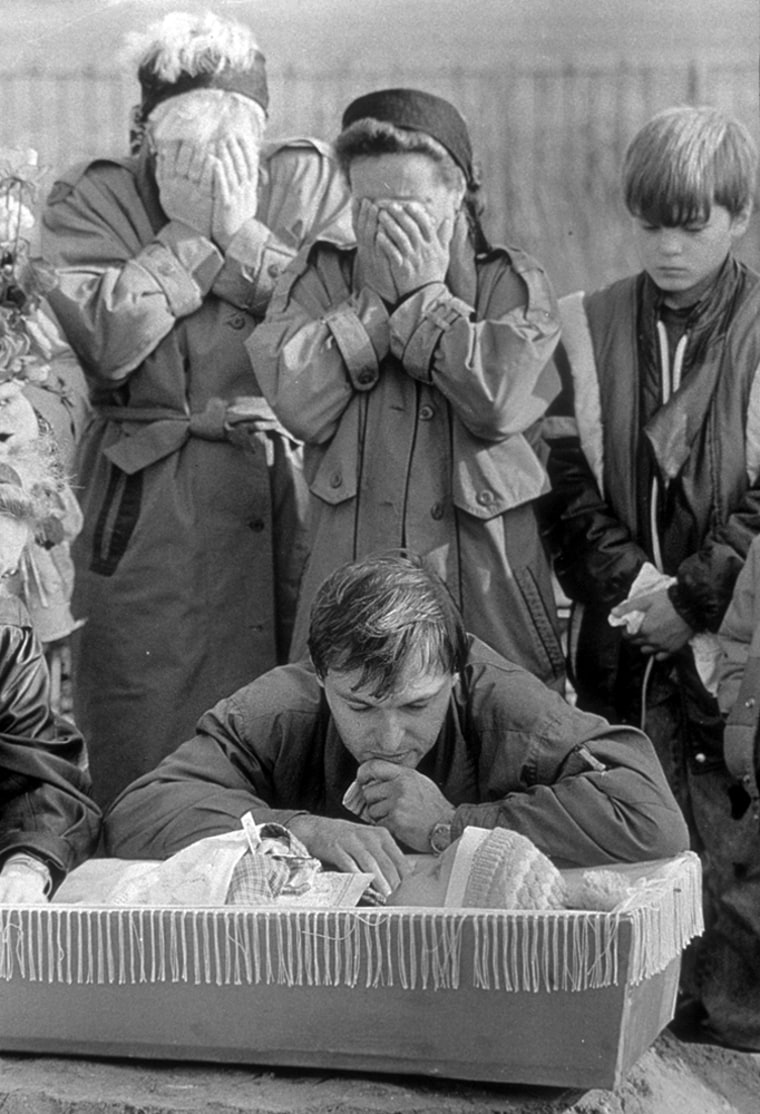

In this 1986 photo, a Chernobyl nuclear power plant worker holding a dosimeter to measure radiation level is seen agaInst the background of a sarcophagus under construction over the 4th destroyed reactor on this file photo taken in 1986. On May 12, 1986, more than two weeks after the explosion, the leading Soviet daily newspaper Pravda published its first photograph from the site for the first time, shot three days earlier from a helicopter by Repik. \"If I had been ordered now to get aboard and go, I would not have gone _ you might have easily died there for nothing,\" said the 65-year-old Repik.(AP Photo/Volodymyr Repik)
— Volodymyr Repik / AP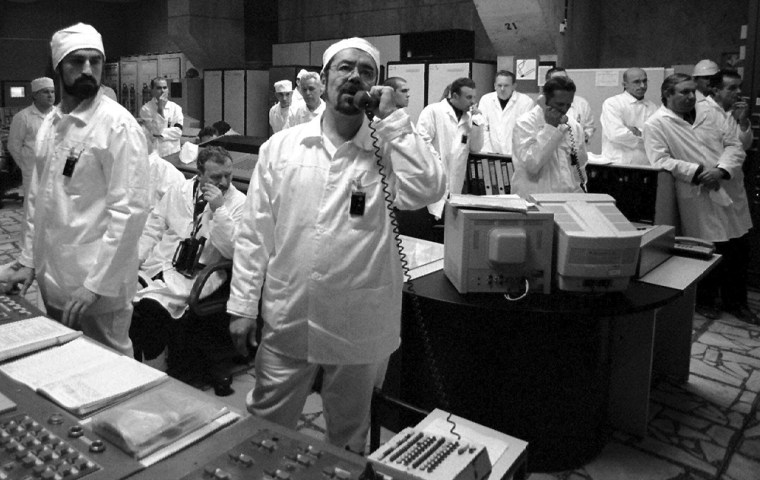
Duty engineers at the Chernobyl nuclear power plant stand at their stations moments after the plant's third reactor was shutdown in Chernobyl, Ukraine Friday Dec. 15, 2000. Chernobyl's third reactor was shut down permanently on Friday, officially closing the the plant that caused the world's worst nuclear accident in 1986. (AP Photo/Pool)
— POOL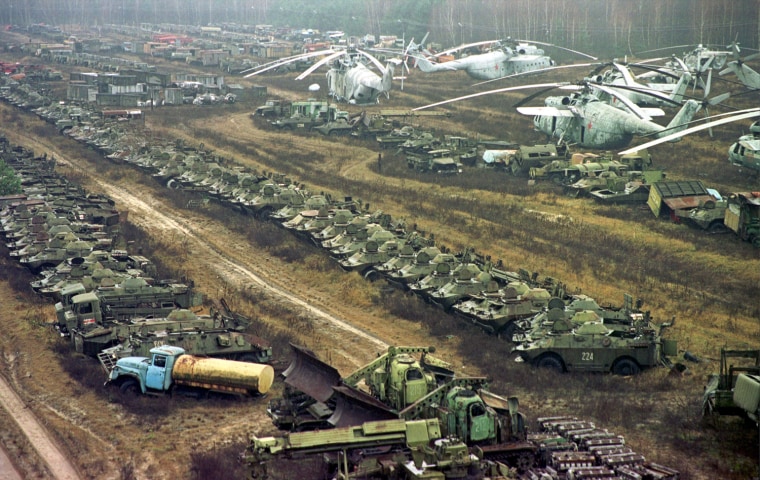
FILE - In this Nov.10, 2000 file photo radioactive contaminated vehicles lay dormant near the Chernobyl nuclear power plan. Some 1,350 Soviet military helicopters, buses, bulldozers, tankers, transporters, fire engines and ambulances were used while fighting against the April 26, 1986 nuclear accident at Chernobyl. All were irradiated during the clean-up operation. Twenty-five years ago, the Chernobyl Nuclear Power Plant exploded in Ukraine, spreading radioactive material across much of the Northern Hemisphere. (AP Photo/Efrem Lukatsky)
— Efrem Lukatsky / AP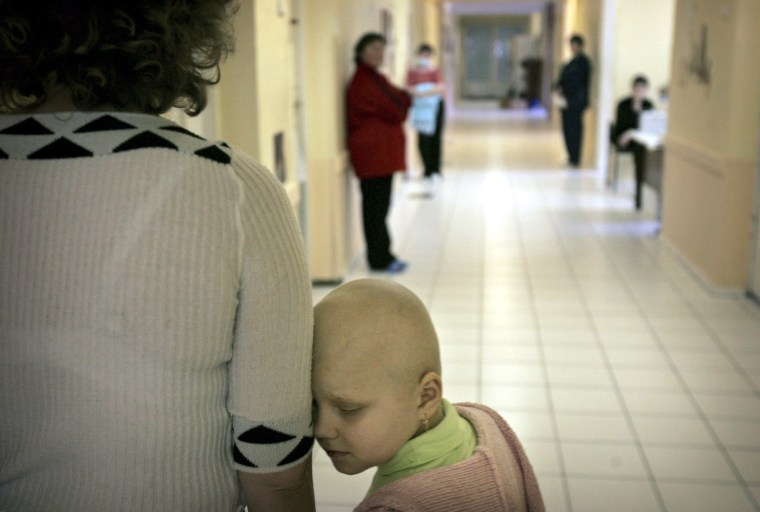
Vika Chervinska, an eight-year-old Ukrainian girl suffering from cancerwaits to receive treatment with her mother at the children's hospital in Kiev Tuesday, April 18, 2006. Greenpeace said Tuesday in a new report that more than 90,000 people were likely to die of cancers caused by radiation from the Chernobyl nuclear disaster, countering a United Nations report that predicted the death toll would be around 4,000. The differing conclusions underline the contentious uncertainty that remains about the health effects of the world's worst nuclear accident as its 20th anniversary approaches. The world will mark the 20th anniversary this month of the explosion at the Chernobyl nuclear power plant, which sent a radioactive cloud across Europe. (AP Photo/Oded Balilty)
— Oded Balilty / AP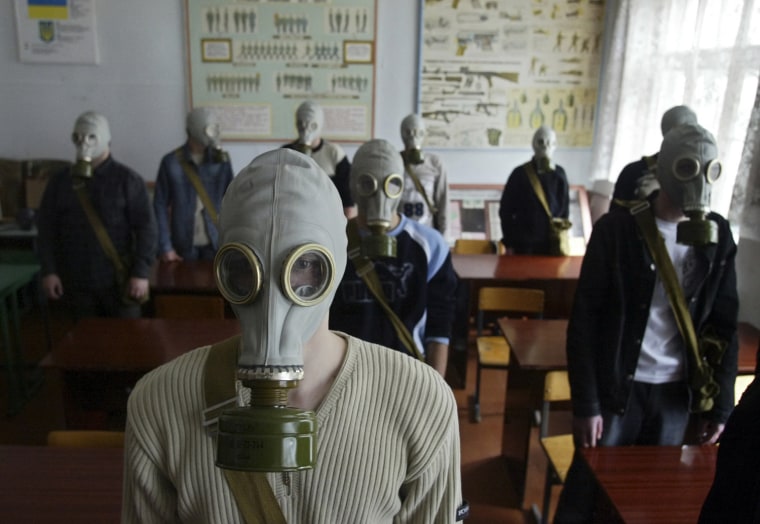
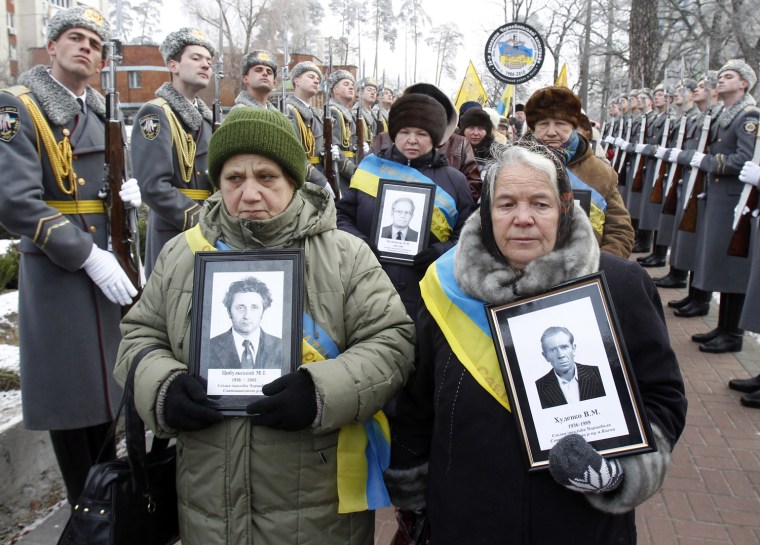
Women hold portraits of emergency workers who fought the blaze at the Chernobyl nuclear reactor, as they walk past a guard of honour during a commemoration ceremony in Kiev, in this December 14, 2010 file photo. Belarus, Ukraine and Russia will mark the 25th anniversary of the nuclear reactor explosion in Chernobyl, the place where the world's worst civil nuclear accident took place, on April 26, 1986. REUTERS/Gleb Garanich/Files (UKRAINE - Tags: ENVIRONMENT DISASTER ENERGY ANNIVERSARY HEALTH POLITICS)
— Gleb Garanich / X00550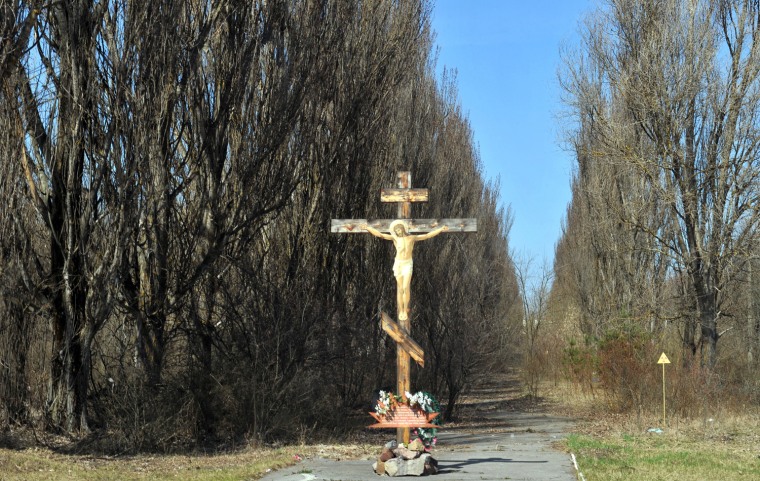
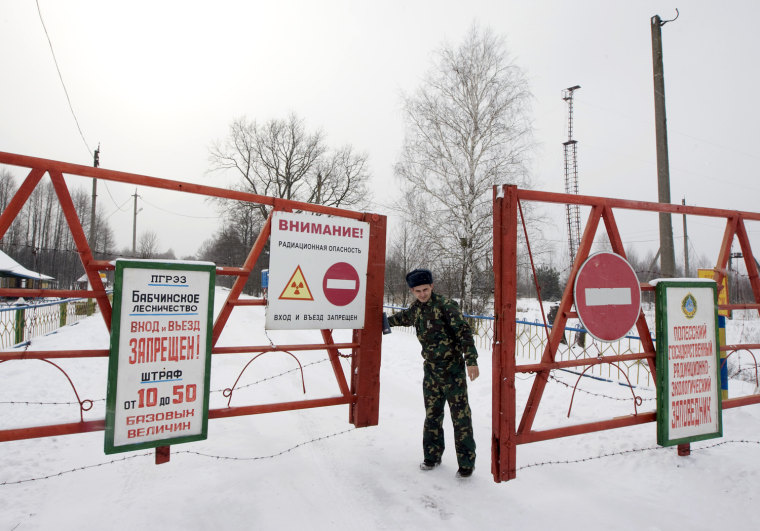
REFILE - ADDITIONAL CAPTION INFORMATION
A Belarussian guard opens the gate at the entrance to the state radiation ecology reserve in the 30 km (18 miles) exclusion zone around the Chernobyl nuclear reactor near the village of Babchin, some 370 km (217 miles) southeast of Minsk, February 21, 2011. Belarus, Ukraine and Russia will mark the 25th anniversary of the nuclear reactor explosion in Chernobyl, the place where the world's worst civil nuclear accident took place, on April 26. REUTERS/Vasily Fedosenko (BELARUS - Tags: ANNIVERSARY DISASTER)
— Vasily Fedosenko / X00829
Wild boars walk in the forest of the state radiation ecology reserve in the 30-km (19 miles) exclusion zone around the Chernobyl nuclear reactor near the village of Babchin, some 370 km (230 miles) southeast of Minsk, February 22, 2011. Still inhospitable to humans, the Chernobyl \"exclusion zone\" -- a contaminated 30-km radius around the site of the nuclear reactor explosion of April 26, 1986 -- is now a nature reserve and teems with wild animals and birds. Belarus, Ukraine and Russia will mark the 25th anniversary of the nuclear reactor explosion in Chernobyl, the place where the world's worst civil nuclear accident took place, on April 26. REUTERS/Vasily Fedosenko (BELARUS - Tags: ANNIVERSARY DISASTER ANIMALS)
— Vasily Fedosenko / X00829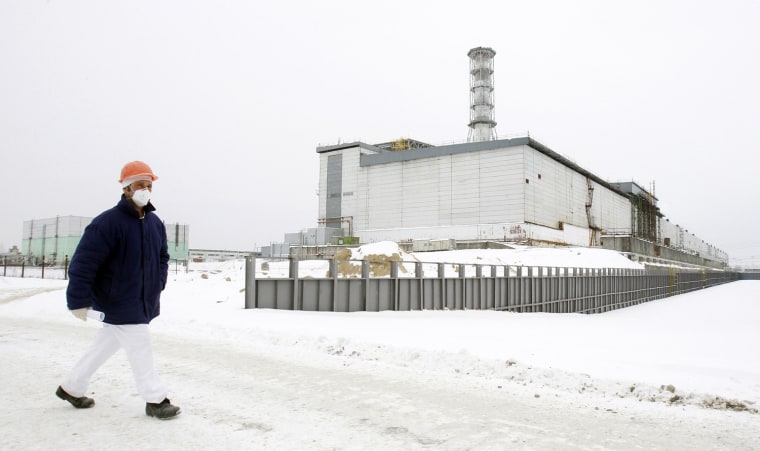
A visitor walks in front of the damaged fourth reactor at the Chernobyl nuclear power plant in this February 24, 2011 file photo. Belarus, Ukraine and Russia will mark the 25th anniversary of the nuclear reactor explosion in Chernobyl, the place where the world's worst civil nuclear accident took place, on April 26, 1986. REUTERS/Gleb Garanich/Files (UKRAINE - Tags: ENVIRONMENT DISASTER ENERGY ANNIVERSARY HEALTH POLITICS)
— Gleb Garanich / X00550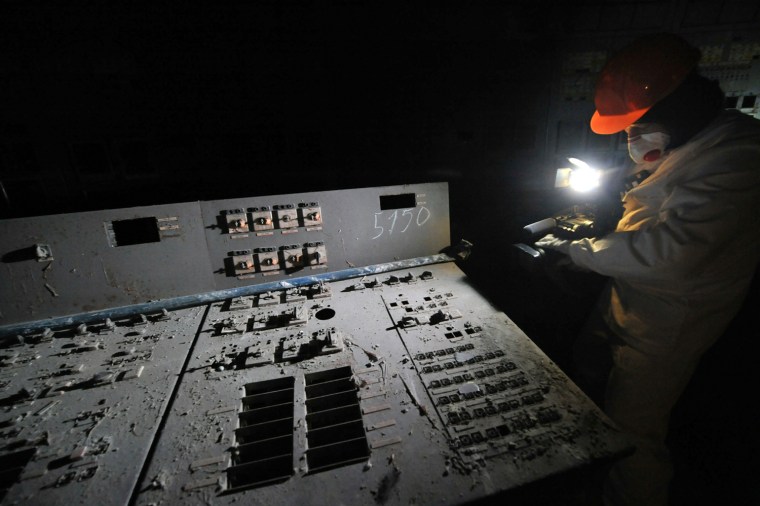
A visitor of the Chernobyl Nuclear Power Plant films in the control room of the destroyed 4th block of the plant on February 24, 2011 ahead of the 25th anniversary of the meltdown of reactor number four due to be marked on April 26, 2011. Ukraine said early this year it will lift restrictions on tourism around the Chernobyl nuclear power plant, formally opening the scene of the world's worst nuclear accident to visitors. Chernobyl's number-four reactor, in what was then the Soviet Union and now Ukraine, exploded on April 26, 1986, sending a radioactive cloud across Europe and becoming the world's worst civilian nuclear disaster. Following the accident, a concrete sarcophagus was built over the stricken reactor and a new 20,000-tonne steel case to cover the whole plant is planned on being constructed between 2008 and 2009. AFP PHOTO/ SERGEI SUPINSKY (Photo credit should read SERGEI SUPINSKY/AFP/Getty Images)
— Sergei Supinsky / AFP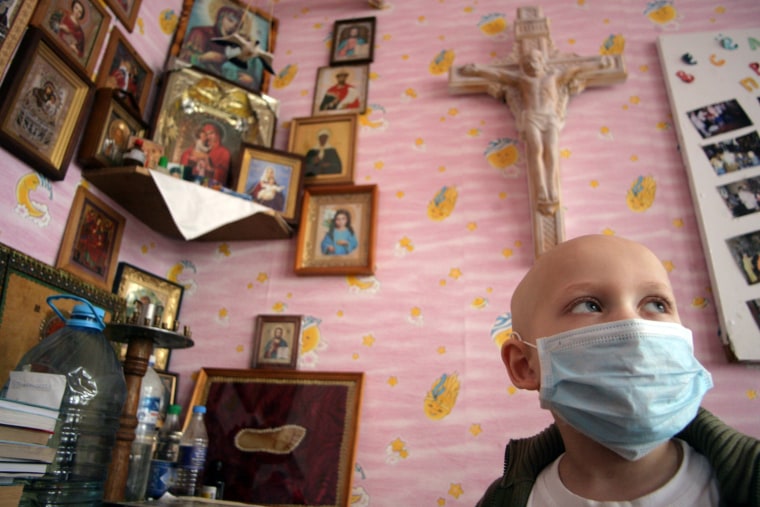
A child wears a mask at a hospital for people suffering from leukemia in the eastern Ukrainian city of Donetsk, on March 23, 2011. Ukrainian children and adults, some of them victims of the 1986 Chernobyl nuclear plant accident, undergo medical treatment at the Oncological Hospital in Donetsk. The blasts at the Soviet-era plant created a cloud of radioactive dust that drifted over a large swathe of Europe and still haunts millions of people in Ukraine and its neighbors.AFP PHOTO / ALEXANDER KHUDOTEPLY (Photo credit should read Alexander KHUDOTEPLY/AFP/Getty Images)
— Alexander Khudoteply / AFP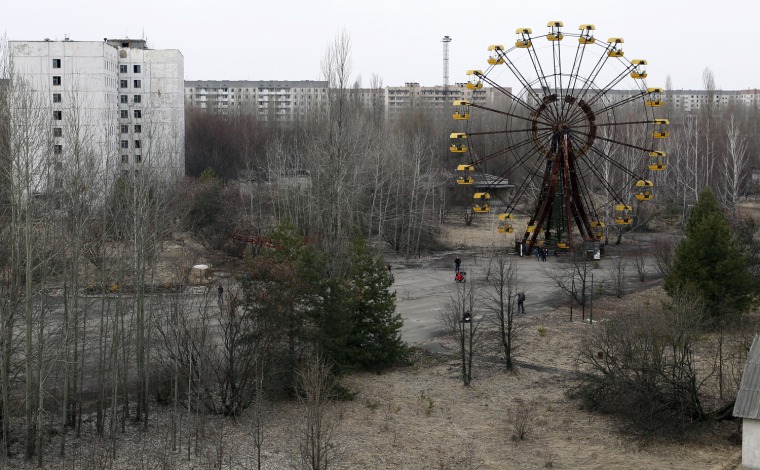
A view of the abandoned city of Prypiat, near the Chernobyl nuclear power plant March 31, 2011. Belarus, Ukraine and Russia will mark the 25th anniversary of the nuclear reactor explosion in Chernobyl, the place where the world's worst civil nuclear accident took place, on April 26. REUTERS/Gleb Garanich (UKRAINE - Tags: DISASTER ENERGY ANNIVERSARY ENVIRONMENT BUSINESS CITYSCAPE)
— Gleb Garanich / X00550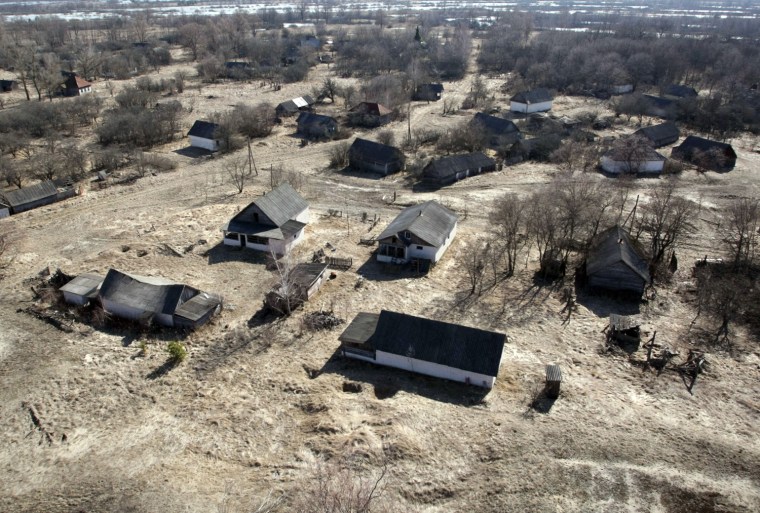
epa02649520 An aerial view of the abandoned village Krasnoselje in the state radiation ecology reserve in the 30 km exclusion zone around the Chernobyl nuclear reactor, some 390 km from Minsk, Belarus, 23 March 2011. The inhabitants of the village were evacuated five days after the blast at the Chernobyl nuclear plant on 26 April 1986. Belorussians will mark the 25th anniversary of the world's yet worst nuclear power accident on 26 April 2011. EPA/TATYANA ZENKOVICH
— Tatyana Zenkovich / EPA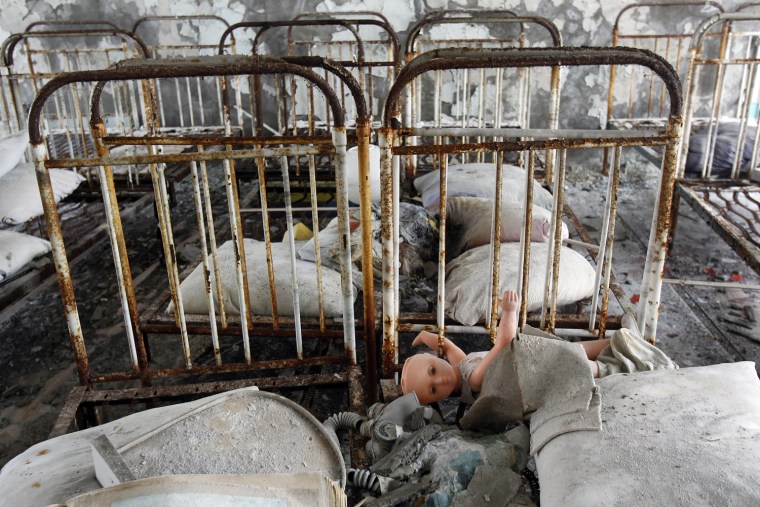
A child gas mask and a doll are seen inside a kindergarten in the abandoned city of Prypiat near the Chernobyl nuclear power plant April 4, 2011. Belarus, Ukraine and Russia will mark the 25th anniversary of the nuclear reactor explosion in Chernobyl, the place where the world's worst civil nuclear accident took place, on April 26. Engineers are still struggling to regain control of damaged reactors at the Fuskushima plant after last month's earthquake and tsunami, in the worst nuclear crisis since Chernobyl in 1986, with the government urging the operator of the plant to act faster to stop radiation spreading. REUTERS/Gleb Garanich (UKRAINE - Tags: ANNIVERSARY DISASTER ENERGY ENVIRONMENT)
— Gleb Garanich / X00550
Local resident Ivan Ilchenko, 76, walks in a field in the village of the Kupovate in the 30 km zone around the Chernobyl nuclear power plant, April 4, 2011. Belarus, Ukraine and Russia will mark the 25th anniversary of the nuclear reactor explosion in Chernobyl, the place where the world's worst civil nuclear accident took place, on April 26. Engineers are still struggling to regain control of damaged reactors at the Fuskushima plant after last month's earthquake and tsunami, in the worst nuclear crisis since Chernobyl in 1986, with the government urging the operator of the plant to act faster to stop radiation spreading. REUTERS/Gleb Garanich (UKRAINE - Tags: ANNIVERSARY DISASTER ENERGY ENVIRONMENT)
— Gleb Garanich / X00550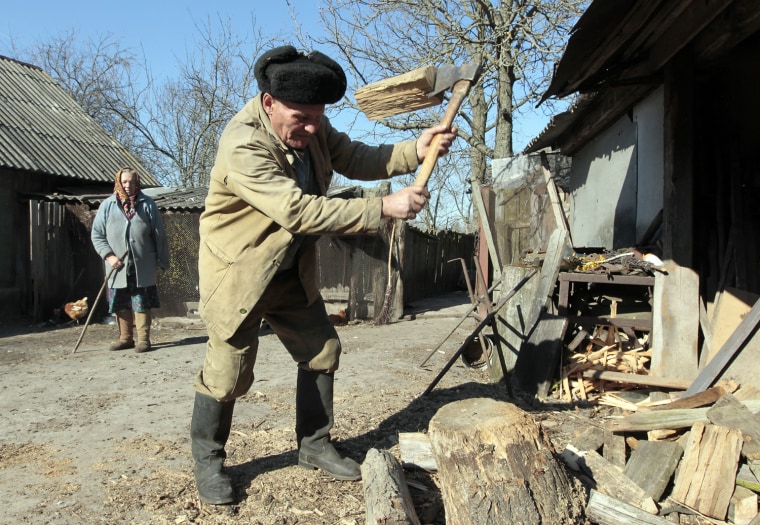
epa02696819 Ivan Semenyuk, (R), 74, chops wood as his wife Maria Semenyuk, 72, (L) looks on at their house in the deserted village of Paryshev, 25 km of the Chernobyl nuclear power plant, Ukraine, 20 April 2011. More than 330 residents refused relocation after the 1986 nuclear accident in reactor number four, choosing to live within the 30 kilometre exclusion zone erected around the contaminated plant. One of two reactors at the Chernobyl nuclear power station exploded during a power test in 1986. 47,000 people of the city of Pripyat were evacuated after the explosion on 26 April 1986. Ukrainians will mark the 25th anniversary of the world's worst nuclear power accident on 26 April 2011. EPA/SERGEY DOLZHENKO
— Sergey Dolzhenko / EPA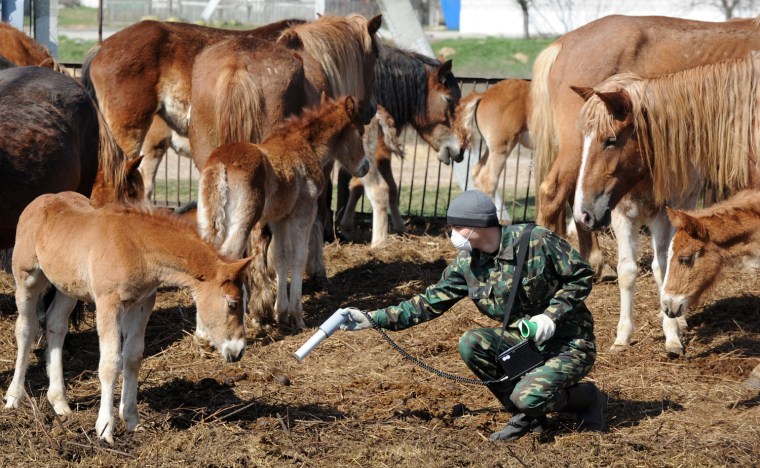
A worker from the State Radiation Ecological Reserve tests radiation levels at a farm in Vorotets on April 21, 2011 close to the 30km exclusion zone around the Chernobyl nuclear reactor. April 26 marks the 25th anniversary of the Chernobyl nuclear disaster. One fifth of Belarus' agricultural land was contaminated following the blast at the nuclear reactor in the Ukraine and around 70% of the fallout fell in Belarus.
AFP PHOTO / VIKTOR DRACHEV (Photo credit should read VIKTOR DRACHEV/AFP/Getty Images)
— Viktor Drachev / AFP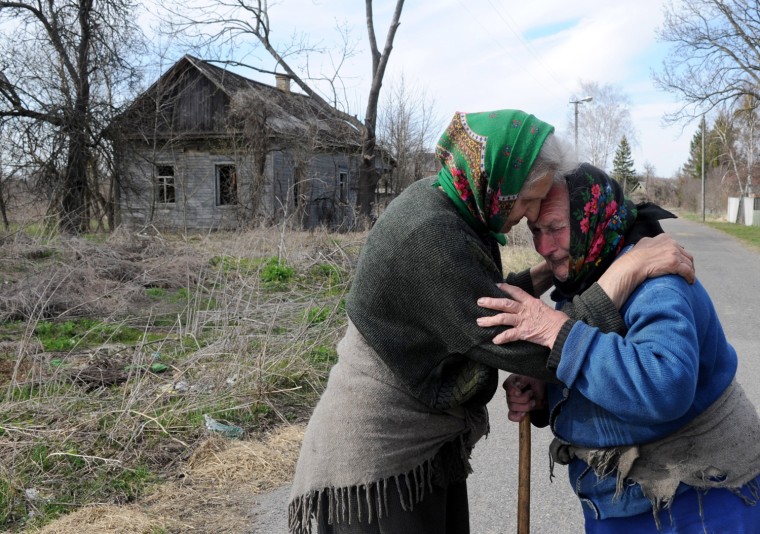
Seventy-two year old Natalia Makeenko (L) hugs eighty-two year old Galina Shcyuka in the abandoned village of Savichi on April 21, 2011 close to the 30km exclusion zone around the Chernobyl nuclear reactor and 400 km south-east of Minsk. April 26 marks the 25th anniversary of the Chernobyl nuclear disaster. One fifth of Belarus' agricultural land was contaminated following the blast at the nuclear reactor in the Ukraine and around 70% of the fallout fell in Belarus.
AFP PHOTO/VIKTOR DRACHEV (Photo credit should read VIKTOR DRACHEV/AFP/Getty Images)
— Viktor Drachev / AFP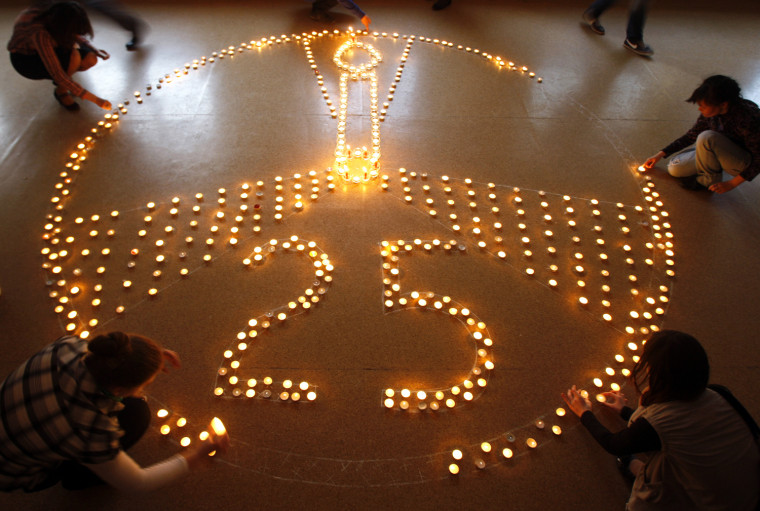
Pupils and teachers of the ecological gymnasium light candles to commemorate victims of the Chernobyl nuclear disaster in Minsk, Belarus, Monday, April 25, 2011. The blast on April 26, 1986, spewed a cloud of radioactive fallout over much of Europe and forced hundreds of thousands from their homes in the most heavily hit areas in Ukraine, Belarus and western Russia. The disaster did not become public knowledge for several days, because Soviet officials released no information until 72 hours after the accident. (AP Photo/Sergei Grits)
— Sergei Grits / AP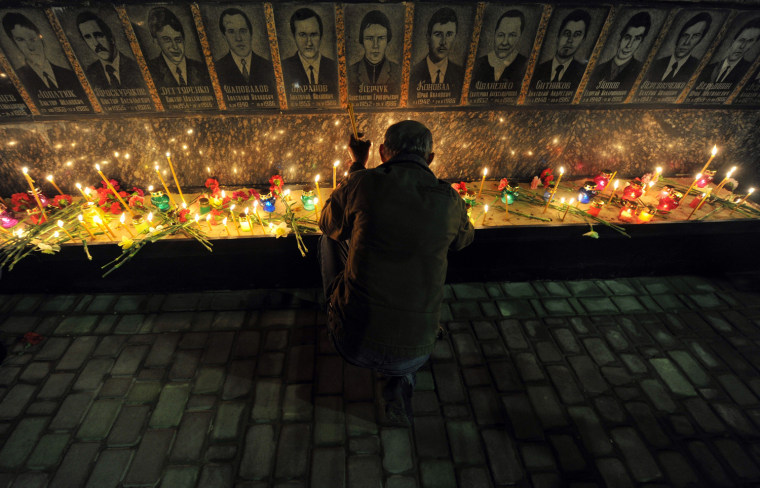
A man grieves at the monument to Chernobyl victims in Slavutich, some 50 kilometres (30 miles) away from the accident site, and where many of the power station's personnel used to live, during a memorial ceremony early on April 26, 2011. The world on April 26 marks a quarter century since the world's worst nuclear disaster at Chernobyl in Ukraine. AFP PHOTO / SERGEI SUPINSKY (Photo credit should read SERGEI SUPINSKY/AFP/Getty Images)
— Sergei Supinsky / AFP1/29
